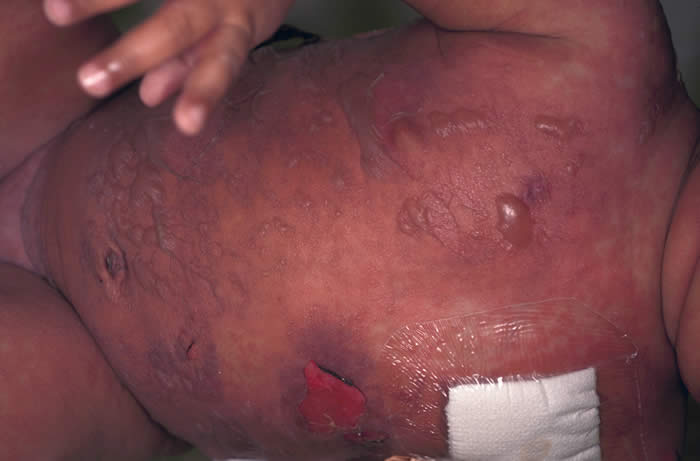Acute Graft Versus Host Disease (aGVHD)
Occurs because alloreactive T-cells from the donor recognize foreign tissue of the host.
Classically occurs within first 100 days of transplant. Now recognized to occur even later in some patients as a distinct clinical entity from chronic GvHD.
Three primary organ systems are affected by aGvHD:
- Skin
- Gastrointestinal Tract
- Liver
Figure: Acute Stage 3 Skin GvHD

Figure: Acute Stage 4 Skin GvHD with desquamation of skin. This severe aGvHD is of similar severity to a burn victim.

Combined immunosuppression is used after transplant for prophylaxis against aGvHD. Multiple regimens exist. Classic aGvHD prophylaxis regimens use combinations of
- Cyclosporin (a T-cell inhibiting calcineurin inhibitor)
- Short courses of lower dose methotrexate
- Corticosteroids
- Other regimens use tacrolimus (another T-cell inhibiting calcineurin inhibitor) and mycophenolate mofetil.
Despite prophylaxis some patients still develop aGvHD and need to be treated.
aGvHD (particularly when severe) is a major contributor to transplant related mortality and morbidity.
Each of the three primary organ systems are staged to reflect their relative severity:
Stage |
Skin Rash |
Gastrointestinal |
Liver (Total Bilirubin) |
I |
< 25% BSA |
Diarrhea 5-10 mL/kg/day or persistent nausea |
32.2-64.4 mmol/L |
II |
25-50% BSA |
Diarrhea 10-15 ml/kg/day |
64.4-102.6 mmol/L |
III |
50-100% BSA |
Diarrhea >15 mL/kg/day |
102.6-256.6 mmol/L |
IV |
Desquamation of Skin and Bullae Formation |
Severe abdominal pain and ileus |
> 256.6 mmol/L |
Stages of aGvHD for the three major organ systems are then combined to provide an overall grade of aGvHD:
- Grade I: Mild aGvHD (requires no treatment)
- Grade II: Moderate aGvHD (requires treatment)
- Grade III: Severe aGvHD (requires treatment)
- Grade IV: Life-Threatening aGvHD (requires treatment and aggressive supportive care)
Treatment of aGvHD:
Moderate doses of systemic corticosteroids are first line therapy (e.g. Methylprednisilone 2 mg/kg/day IV divided q12 hour).
Patient remains on corticosteroids until a response is determined and then steroids are tapered over weeks.
If after 5 days there is no response or progression to higher grades, second line agents for treatment of aGVHD are initiated.
Second-Line Treatments for steroid-refractory aGvHD:
- Many options exist. Little literature to support one over another.
- Examples of second line agents include:
- Anti-thymocyte globulin (ATG)
- monoclonal antibody that selectively depletes T-cells
- Campath-1H
- monoclonal antibody that depletes a number of mononuclear cell types
- Etanercept (TNF-a receptor antagonist)
- Infliximab (TNF-a antagonist)
- Sirolimus
- Mycophenolate Mofetil
- Extracorporeal Photopheresis
- Anti-thymocyte globulin (ATG)
Experimental studies are showing good promise in infusing mesenchymal stem cells (MSCs) as therapy for steroid-refractory aGvHD.
MSCs can be harvested from bone marrow of alternative donors (e.g. from a parent) and isolated. MSCs have immunomodulating properties that suppress alloreactive T-cells causing aGvHD.

